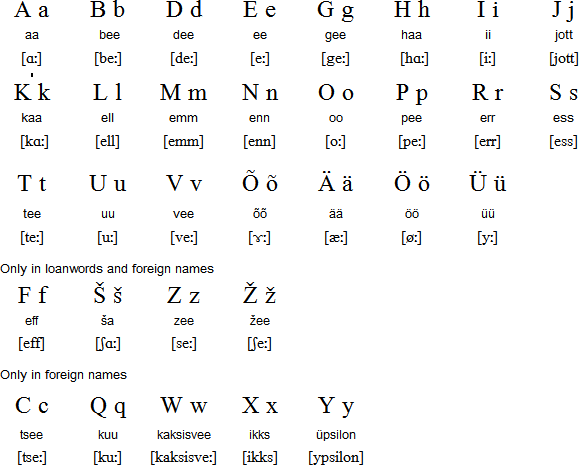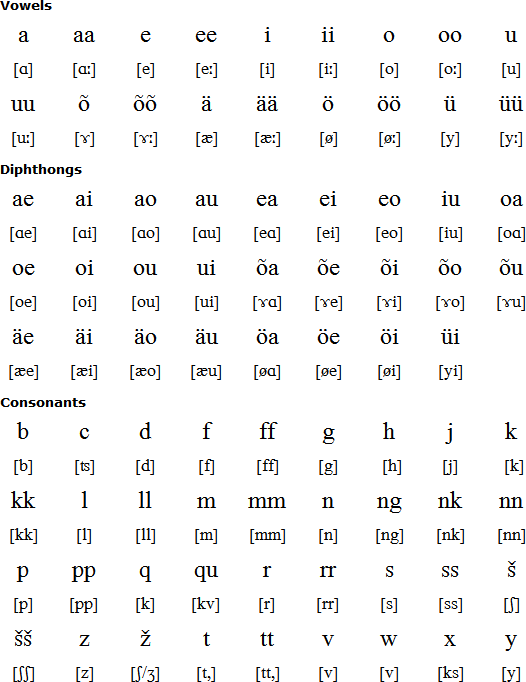Estonian is a Southern Finnic language spoken mainly in Estonia. There are also Estonian speakers in Finland and Australia. In 2012 there were 1.05 million speakers of Estonia in Estonia, and in 2016 there were 49,200 Estonian speakers in Finland, mainly in the south, and about 1,840 Estonian speakers in Australia.
Estonian has two groups of dialects: northern and southern. The northern dialects are associated with the city of Tallinn, and the southern ones with Tartu. Standard Estonian is based on the northern dialects. The southern dialects are sometimes considered separate languages.
Estonian was the state language of Estonia from 1919 to 1945. During the Soviet period Estonian was one of the official languages, along with Russian, and most Estonians became bilingual in Estonian and Russian. Non-Estonians had to learn Estonian in school, however many considered learning the language unnecessary. After the collapse of the Soviet Union in 1989, Estonian became the state language once more, and Russian was discouraged. Estonian is currently an official language in Estonia and the EU.
Estonian belongs to the Finnic branch of the Uralic language family. It is classified as belonging to the Southern Finnic group of languages, along with Livonian and Votic. Estonian and Finnish are related, and there is some mutually intelligiblity betwen them. Many older Estonians, particularly those who grew up during the Soviet period, can understand Finnish as they have studied it, and/or listen to Finnish radio and television [source].
The oldest examples of written Estonian are names, words, and phrases found in early 13th century chronicles. The earliest surviving longer text dates from the 16th century. An Estonian textbook first appeared in 1637. Ferdinand Johann Wiedemann published the comprehensive Estonian-German dictionary in 1869, and a grammar describing the Estonian language in 1875. Most Estonian literature has been produced since the early 19th century, and particularly in the early 20th century.
When Estonian was first written there was no standard alphabet. People used an ad hoc spelling system based on Latin and Middle Low German. In the 17th century Bengt Gottfried Forselius and Johann Hornung created a way of writing Estonian based on German. That was replaced by a Finnish-based orthography, known as the Newer Orthography, created by Eduard Ahrens in the second half of the 19th century. This was the basis for the current orthography.

Hear the Estonian alphabet

Information about the Estonian alphabet and pronunciation compiled by Wolfram Siegel, with corrections by Allan Kiisk, and some details from: http://www.eki.ee/knn/ungegn/un7_gdl.htm
Kõik inimesed sünnivad vabadena ja võrdsetena oma väärikuselt ja õigustelt. Neile on antud mõistus ja südametunnistus ja nende suhtumist üksteisesse peab kandma vendluse vaim.
A recording of this text by Ülle Hahndorf
All human beings are born free and equal in dignity and rights. They
are endowed with reason and conscience and should act towards one another
in a spirit of brotherhood.
(Article 1 of the Universal Declaration of Human Rights)
Information about Estonian | Phrases | Numbers | Time | Family words | Proverbs | Tongue twisters | Tower of Babel | Learning materials
Information about the Estonian language
http://www.einst.ee/publications/language/language.html
Online Estonian lessons
http://www.loecsen.com/travel/0-en-14-2-21-free-lessons-estonian.html
http://www.speaklanguages.com/estonian/
http://ikindalikelanguages.com/labs/courses.php?id=35
http://www.panglosskool.eu/index.php?id=24
http://polymath.org/estonian.php
https://play.google.com/store/apps/details?id=com.gertoja.threeweekestonianfree
Estonian phrases
http://www.speaklanguages.com/estonian/phrases/
http://www.downloadalanguage.com/downloadalanguage/Estonian_phrases.html
http://www.bbc.co.uk/languages/other/quickfix/estonian.shtml
Online Estonian dictionaries
http://www.ibs.ee/dict/
http://www.dictionaric.com/dicoestonien/dicoestonien.php
Online Estonian radio
http://www.err.ee
http://www.elmar.ee
http://www.kuku.ee
http://www.raadio.net
Online Estonian news
http://epl.delfi.ee
http://www.postimees.ee
http://www.ohtuleht.ee
Estonian, Finnish, Karelian, Kven, Livvi-Karelian, Livonian, Ludic, Meänkieli, Seto, Veps, Võro, Votic
Languages written with the Latin alphabet
Page last modified: 14.04.24
[top]
You can support this site by Buying Me A Coffee, and if you like what you see on this page, you can use the buttons below to share it with people you know.

If you like this site and find it useful, you can support it by making a donation via PayPal or Patreon, or by contributing in other ways. Omniglot is how I make my living.
Note: all links on this site to Amazon.com, Amazon.co.uk
and Amazon.fr
are affiliate links. This means I earn a commission if you click on any of them and buy something. So by clicking on these links you can help to support this site.
[top]